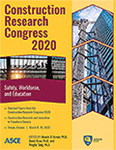Construction Research Congress 2020
Spatiotemporal Characteristics and Behavioral Factors of Fatal Construction Accidents in China, 2012–2018
Publication: Construction Research Congress 2020: Safety, Workforce, and Education
ABSTRACT
Finding the characteristics of construction accidents will be beneficial to make appropriate safety strategies and policies. However, due to the socioeconomic backgrounds, the characteristics of construction accidents vary from different countries or districts. The purpose of this study is to identify the spatiotemporal characteristics of fatal construction accidents in China and to explore the causes related with behavioral factors. With the data of 4,061 fatal construction accidents in China, the spatial and temporal features were examined. The behavioral factors were also analyzed applying the technique of human factor analysis and classification system (HFACS). The results show that the numbers of accidents and fatalities differ greatly by months, weeks, hours, provinces, and regions. These differences may be affected by various organizational, managerial, and individual factors. Behavioral factors are critical for 4 main types of accidents: fall, object striking, collapse, and hoisting injury. 23 common unsafe behaviors such as failure to detect warning signs of accidents in time are explored related with these accidents. The results indicate that safety practitioners should pay attention to the spatiotemporal variances of construction accidents and focus on the behavioral factors. The flexible safety plans involving more human factors may be necessary in order to reduce construction accidents and to keep the sites safer.
Get full access to this article
View all available purchase options and get full access to this chapter.
REFERENCES
Arquillos, A. L., Romero, J. C. R., and Gibb, A. (2012). “Analysis of construction accidents in Spain, 2003-2008.” J. Saf. Res., 43(5-6), 381-388.
Bureau of Labor Statistics (BLS). (2014). “Fatal occupational injuries by industry and event or exposure. ” <http://www.bls.gov/iif/oshwc/cfoi/cfch0011.pdf.
Chiang, Y. H., Wong, F. K. W., and Liang, S. (2017). “Fatal construction accidents in Hong Kong.” J. Constr. Eng. Manag., 144(3), 04017121.
Choi, B., Ahn, S., and Lee, S. H. (2017). “Role of social norms and social identifications in safety behavior of construction workers. I: theoretical model of safety behavior under social influence.” J. Constr. Eng. Manag., 143(5), 04016124.
Fang, D., Wu, C., and Wu., H. (2015). “Impact of the supervisor on worker safety behavior in construction projects.” J. Manag. Eng., 31(6):04015001.
Feng, Y., Zhang, S., and Wu, P. (2015). “Factors influencing workplace accident costs of building projects.” Saf. Sci., 72, 97-104.
Gambatese, J. A., Pestana, C., and Lee, H. W. (2017). “Alignment between lean principles and practices and worker safety behavior.” J. Constr. Eng. Manag., 143(1), 04016083.
Guo, B. H., Goh, Y. M., and Wong, K. L. X. (2018). “A system dynamics view of a behavior-based safety program in the construction industry.” Saf. Sci., 104, 202-215.
Hale, A., Walker, D., Walters, N., and Bolt, H. (2012). “Developing the understanding of underlying causes of construction fatal accidents.” Saf. Sci., 50(10), 2020-2027.
Kang, Y., Siddiqui, S., Suk, S. J., Chi, S., and Kim, C. (2017). “Trends of fall accidents in the U.S. construction industry.” J. Constr. Eng. Manag., 143(8), 04017043.
Li, Y., Hu, Y., Xia, B., Skitmore, M., and Li, H. (2018). “Proactive behavior-based system for controlling safety risks in urban highway construction megaprojects.” Autom. Constr., 95, 118-128.
McCabe, B. Y., Alderman, E., Chen, Y., Hyatt, D. E., and Shahi, A. (2017). “Safety performance in the construction industry: Quasi-longitudinal study.” J. Constr. Eng. Manag., 143(4), 04016113.
Ministry of Housing and Urban-Rural Development of China (MOHURD). (2019), “Construction accident bulletin.” <http://sgxxxt.mohurd.gov.cn/Public/AccidentList.aspx.
National Bureau of Statistics of China (NBSC). (2018), China Statistical Yearbook-2018, China Statistics Press, Beijing.
State Administration of Work Safety (SAWS). (2005-2018), China Safety Production Yearbook (2004-2016), Coal Industry Press, Beijing.
Wiegmann D A, and Shappell S A. (2003), A human error approach to aviation accident analysis: The human factors analysis and classification system, Ashgate Publishing Limited, Cornwall.
Winge, S., and Albrechtsen, E. (2018). “Accident types and barrier failures in the construction industry.” Saf. Sci., 105, 158-166.
Winge, S., Albrechtsen, E., and Mostue, B. A. (2019). “Causal factors and connections in construction accidents.” Saf. Sci., 112, 130-141.
Information & Authors
Information
Published In
Construction Research Congress 2020: Safety, Workforce, and Education
Pages: 195 - 203
Editors: Mounir El Asmar, Ph.D., Arizona State University, David Grau, Ph.D., Arizona State University, and Pingbo Tang, Ph.D., Arizona State University
ISBN (Online): 978-0-7844-8287-2
Copyright
© 2020 American Society of Civil Engineers.
History
Published online: Nov 9, 2020
Published in print: Nov 9, 2020
Authors
Metrics & Citations
Metrics
Citations
Download citation
If you have the appropriate software installed, you can download article citation data to the citation manager of your choice. Simply select your manager software from the list below and click Download.
